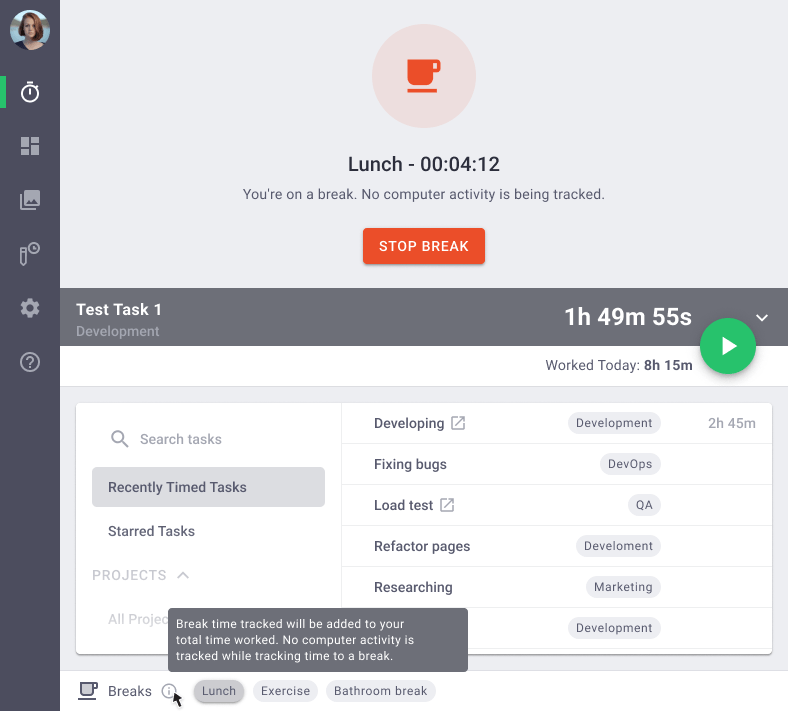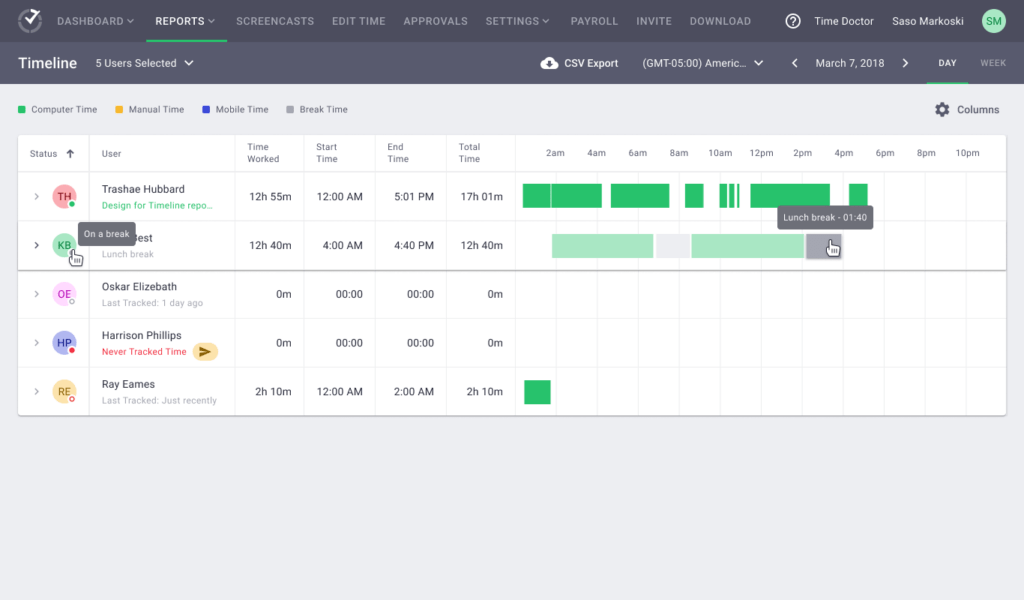We are very excited to announce the release of a long-awaited feature – Time Doctor Breaks! Our newest feature enhances the already powerful Time Doctor reports with even more accuracy and clarity on how time is spent at your organization.
Say goodbye to workarounds and manually adding up break times for your employees. We’ve made it simple for organizations to track different types and durations of breaks for all teams. Both managers and employees will benefit from deeper levels of visibility and insight into daily timelines and work patterns.
Read on to see how Time Doctor Breaks works and why tracking breaks is so important to the success of your company.
How it works
Admins will now have the ability to create custom paid breaks in Time Doctor for the entire organization, specific groups and departments, or for individual users. They can control what type of breaks are available and what to name them.
Each break created will show up in the desktop app where employees can easily choose what type of work break they are taking and start tracking time with the click of a button. When they are ready to get back to work, it’s just as easy as clicking the “Start” button again.

The best part of the new Breaks feature is that not only are you increasing your time tracking accuracy, but you will also be able to visually see breaks in your favorite Time Doctor reports. The Timeline Report, Activity Summary, and parts of the User Dashboard will now reflect paid breaks as blocks of times colored gray. If users pause outside of paid breaks, it will still show as white gaps indicating times of inactivity.

Don’t forget about work break policies
An important reminder before you start tracking breaks with Time Doctor – make sure you have a break policy in place for your organization. This policy should cover when it’s acceptable to take breaks, the length of breaks, and expectations around the frequency of breaks, so there is no confusion for employees about when it’s ok to take a paid or even unpaid break. Break policies will differ depending on the industry or compliance laws for certain geographic areas, so it’s important to make these as clear as possible for your employees.
For example, the outsourcing industry often has set times to take work breaks. Sometimes work break types are determined by the client that the outsourcer is supporting. While Time Doctor Breaks can be configured to handle either of these situations, this is the type of information that should be reflected in your break policy to avoid any potential issues.
One more tip: when you roll out your break policy, remember to start with the importance of breaks and encourage employees to take them.
Why it’s important to track employee breaks
Now that we know how new Time Doctor Breaks works, why is it important to track work breaks? We’ve listed the top five reasons below, as well as the benefits of tracking breaks with Time Doctor.
1. Improve the accuracy of time tracking reporting
Using Time Doctor to track time and attendance already provides businesses with accurate and reliable workday data. Adding paid breaks into your work days will not only strengthen the accuracy of your reporting, but it will provide more clarity about how time is spent. Viewing paid breaks within the total amount of hours worked gives you more insight into the amount of rest time your teams have.
For companies who bill by the hour, accurate timesheets are an essential part of profitability, as some clients won’t pay for times of inactivity, or they simply need an accurate breakdown of the hours they are paying for.
Similarly, outsourcing companies also need precise reporting so that they can provide proof of work to clients. For a lot of them, breaks are only allowed during set times, making tracking breaks an essential component for evaluating performance.
2. Improve employee accountability
Similar to what we explained above, your business will benefit from increased accountability across your organization by using Time Doctor to track time and attendance. When there is transparency and more visibility, employees inherently become more accountable for their time. Tracking breaks will only boost this feeling of accountability, which can lead to higher productivity and efficiency.
3. Support and aid compliance efforts
Depending on where your employees live, there might be specific labor laws that require you to provide a certain number of breaks that last a specific amount of time. By tracking breaks with Time Doctor, your company can easily stay compliant with these rules and have the data reflected in your reports.
4. Improve productivity
There have been many surveys conducted on the correlation between work breaks and productivity and they all seem to share the same conclusion – taking breaks usually leads to higher productivity. Giving your mind a chance to rest and recharge can have positive effects on the quality and quantity of work. Breaks give you a chance to refocus and motivate yourself to complete that goal or project, resulting in higher productivity. A survey completed by Tork reported that “nearly 90% of North American employees claim that taking a lunch break helps them feel refreshed and ready to get back to work.”
5. Improve employee engagement
Last, but certainly not least, breaks are an essential part of employee engagement and well-being. All companies should be encouraging their employees to take regular breaks during their workday. Not only does this time give employees a chance to recharge and refocus, but it also creates more time for healthy habits. Especially for remote teams, taking time to go for a walk or enjoy a few moments in the sun can improve mental well-being and do wonders for the body. Promoting breaks at work also encourages a healthy work-life balance, which helps reduce employee burnout and raise job satisfaction.
It’s not enough to just allow breaks. You should also reassure employees that breaks should be taken. Employees often skip breaks because they simply don’t have time due to high workloads, or they don’t know they can take breaks. The same Tork survey reported that “nearly 20% of North American workers worry their bosses won’t think they are hardworking if they take regular lunch breaks, while 13% worry their co-workers will judge them.”
For either of these instances, by tracking breaks with Time Doctor, you will get insights and data that help you stay ahead of these potential problems.
So, are you ready to check out Time Doctor Breaks for yourself?

Amy Owens is a product marketing enthusiast with a passion for writing content that communicates the features, values, and benefits of products.


